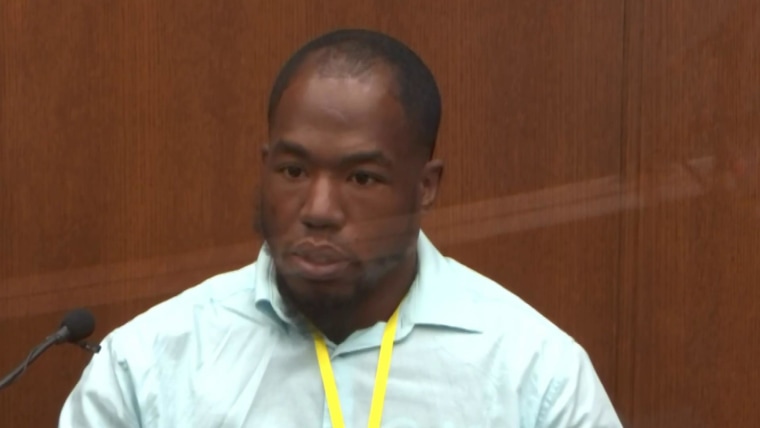Witness: 'I believe I witnessed a murder. I felt the need to call the police on the police.'

Donald Williams II, a mixed martial artist who was among onlookers shouting at Derek Chauvin to get off George Floyd last May, testified Tuesday that he called the police "on the police" after paramedics took Floyd away, because he believed he had "witnessed a murder."
He is the second witness to testify he called the police on the police, after watching the encounter between Floyd and the officers at the scene.
Asked by Assistant Minnesota Attorney General Matthew Frank why he called 911 on May 25, Williams said: "I believe I witnessed a murder. I felt the need to call the police on the police."
"There were police there, right?" Frank responded. "Why didn't you just talk to them about it?"
Williams said: "We just didn't have no connection. I spoke to them but not on a connection of a human being relationship."
Audio of Williams' 911 call was played Tuesday, in which he tells a dispatcher that Floyd was not resisting arrest and had stopped breathing.
"He was already in handcuffs," Williams said, according to audio of the call. "They pretty much just killed that dude. I don't know if he's dead for sure but he was not responsive when the ambulance just came and got him."
Williams was then connected to a police supervisor.
Williams, a former wrestler who said he was trained in chokeholds, testified Monday that Chauvin used a shimmying motion several times to increase the pressure on Floyd. Williams said Chauvin had Floyd pinned in a "blood choke," which compresses arteries or veins in the neck.
George Floyd in 'tremendous pain' in his final moments of life, witness said
George Floyd's final moments of life were spent in "tremendous pain" as he gasped for air and drooled, while pinned under a police officer's knee, a witness said.
"You could see that he (Floyd) was going through tremendous pain, and you can see it in his face," bystander Donald Williams told jurors. "You can see it in his eyes, slowly rolling back in his head and him having his mouth open, wide open, slowly with drool and slobber and dryness on his mouth."
Williams is a mix-martial arts fighter who happened to walk up Cup Foods on May 25 when then-officer Derek Chauvin had Floyd on the ground, under his knee, for about 9 minutes.
"And you can see that he’s (Floyd) trying to gasp for air, trying to be able to breathe as he's down there, trying to move his face side to side, I’m assuming to gasp for more air," Williams said.
Hennepin County Judge Peter Cahill ruled Tuesday that four witnesses who were minors at the time of George Floyd's arrest may testify off-camera, but that audio of their testimony will be broadcast live.
One of the witnesses, Darnella Frazier, recorded the viral bystander video when she was 17.
The ruling was in response to a motion filed Monday by the prosecution asking the court to allow the four witnesses to give their testimony without it being broadcast to the public.
Two of the witnesses have since turned 18.
"This is more to give them comfort testifying as witnesses in what is a very high profile trial," Cahill said. "And given their young age, I am going to grant it as far as these four witnesses, but no others."
Cahill said media outlets can publicly identify them.
Witness testimony resumes with bystander who said Chauvin used 'blood choke' on Floyd
Testimony resumes Tuesday in Hennepin County District Court with a key witness, a bystander, who said he repeatedly pleaded for former Minneapolis police officer Derek Chauvin to release George Floyd from a chokehold.
The bystander, Donald Williams II, testified Monday that his experience as a mixed martial arts trainer and fighter told him that Chauvin's "blood choke" was squeezing the life out of Floyd.
Williams said he saw Floyd "slowly fade away ... like a fish in a bag."
Floyd died May 25 after being pinned by the neck under Chauvin's knee for more than 9 minutes, 29 seconds, prosecutors said Monday.
'I couldn't watch it,' George Floyd's nephew says of graphic video shown in court
George Floyd's nephew, Brandon Williams, said he walked out of the Hennepin County District Court's overflow room Monday when prosecutors showed a graphic bystander video during opening statements of Floyd pinned under Derek Chauvin's knee.
Asked if he had seen the video before, Williams said: "I've seen bits and pieces. I still, to this day, haven't watched it in full."
Williams said his family had been warned about the graphic video and that he tried to prepare himself.
"As they showed Chauvin kneeling on his neck and like kind of repositioning and just hearing my uncle ask for help and say he couldn't breathe, I couldn't watch it," Williams said.
911 dispatcher testifies officers pinned down George Floyd for so long she thought her video feed had frozen
The first witness in Derek Chauvin's murder trial, a 911 dispatcher, testified Monday that she alerted a police supervisor May 25 after she watched Minneapolis police officers pin George Floyd to the ground live in a security video.
The dispatcher, Jena Scurry, said it was a "gut instinct" that led her to call a police sergeant who was a supervisor for the officers at the scene. She said she glanced up at wall-mounted dispatch screens between taking other calls and saw a police squad car moving back and forth outside Cup Foods, a convenience store. An employee at Cup Foods had called police alleging that Floyd had tried to pass a counterfeit $20 bill.
Scurry said the police officers restrained Floyd for so long that she asked someone whether her "screens had frozen because it hadn't changed" and "was told that it was not frozen."
Scurry was one of three witnesses to testify Monday. The two other witnesses were bystanders, Alisha Oyler, who was working at a Speedway station across the street, and Donald Williams II, who had been on his way to Cup Foods. Williams will return to the witness stand when the trial resumes Tuesday.
OPINION: Derek Chauvin's defense strategy in George Floyd trial emphasizes pathology
The prosecution told jurors to "believe your eyes" when they watch and hear about George Floyd's final minutes. And video of the incident may make folks think this is an easy case for prosecutors. But the forensic pathology piece suggests otherwise. (Disclaimer: There is so much that could be written, discussed, argued and debated on the forensic pathology front, but I will touch on only some of the highlights here.)
It's worth mentioning that, in a manual strangulation incident, the victim can lose consciousness within 10 seconds and die in 3 to 5 minutes. Though this may sound counterintuitive, I suspect we will see the defense "embrace" the fact that Derek Chauvin knelt on Floyd for 9 minutes and 29 seconds — not the infamous 8 minutes and 46 seconds, by the way — as evidence suggesting that Chauvin was not putting significant enough pressure on Floyd's neck to kill him via asphyxiation.
We have already seen some of this defense strategy play out in opening statements. Chauvin's lead defense attorney, Eric Nelson, said Floyd displayed "none of the telltale signs of asphyxiation." There was "no evidence that Mr. Floyd's airflow was restricted," he claimed.
I expect that the defense will continue to argue this point throughout the trial, contending that the findings during autopsy suggest that Chauvin was not placing any significant pressure on Floyd's neck and was not impeding his ability to breathe.

